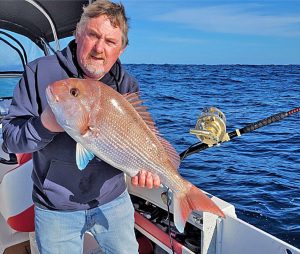
Eli McLoughlin 4, with a sample of his whiting catch of Point Richards.
Corio Bay/Bellarine Peninsula
Launching off Point Richards early last week were Kevin McLoughlin, his 4-year-old son Eli, and friend Marcus Pearson.
As it turned out, they found a good patch of whiting at the east end of mussel farm where young Eli made a major contribution to their respectable catch using pipis and squid for bait.
Heading down toward Leopold last Thursday morning. Andrew Johnson and Denis O’Brien were also after whiting, and – fortunately – dropped in on a good bite straight away.
Anchored up in five meters of water, it took only two hours for each to take their respective bag limit catches of whiting to 43 cm in just two hours using small strips of squid and mussels for bait.

Lockie Wombell with a latchet – more commonly known as flying gurnard – from 130 metres of water off Portland (Picture: Bob McPherson).

Shark wrangler, Lockie Wombell in a wrestling match with a hefty school shark caught from 130 metres of water off Portland (Picture: Bob McPherson).
On Wednesday, Andrew Phillips and Tony Greck launched at Queenscliff and headed down off the mouth of Swan Bay where they usually manage bag limit catches of whiting, but things were slow to begin with.
Never-the-less they persisted and after making a series of moves they got onto a good patch and eventually picked up a bag limit catch of whiting, the biggest measuring 43 cm.
And, with water clarity remaining good on the ebb, they moved in closer to shore where they picked up a bag limit catch of squid on the drift.
On Wednesday morning, Tony Ingram and Col Simmons tried the Queenscliff boat harbour for trevally on the incoming tide but there wasn’t much doing at all.
Heading out to the wreck of the old J class submarine off Swan Island they fished just outside of the Army’s security zone, but found the fishing slow here as well
However, as the incoming tide slowed down at around 3.30 pm, the trevally came on the bite, and they caught a dozen on the pilchard fillets they were using for bait.

Lockie Wombell with one of the snapper that he and Bob McPherson caught out in 130 metres of water off Portland (Picture: Bob McPherson).

Lockie Wombell with a knife jaw caught out in 130 metres of water off Portland (Picture: Bob McPherson).
Portland
With a break in the weather last week, Bob McPherson and Lockie Wombell headed out off Portland into 130 metres of water, in an area known to produce Tasmanian Trumpeter.
Alas, they caught none of those, but they did catch both school and gummy shark, snapper, knife-jaw, and even a latchet, more commonly referred to as flying gurnard.

Joe Baillie of the Greenvale Angling Club with a 3.5 kg brown trout that was taken on a mudeye.
Freshwater
The week previous, I mentioned Darren Zammit’s 4.55 kg brown trout from Lake Purrumbete. Well, his son Chris caught a similar fish last week that weighed 4.3 kg: Both fish were caught on lures.
Joe Baillie of the Greenvale Angling Club was also in the mix with a 3.5 kg brown trout that was taken on a mudeye fished beneath a float.
VFA fish stocking coordinator, Rhiannon Atkinson thanks all who could make it to the release of salmon fry – which were only a few grams in size – into Lake Bullen Merri.
However, with the current low water level at Lake Purrumbete, the stocking of these fish will be pushed back to late September, the date to be confirmed.
Next Thursday, August 22, the remaining tiger trout are scheduled to arrive at Lake Bullen Merri at around 3.00 pm, some 350 fish at a total weight of approximately 35 kg.
Following that, another 2500 tigers are to be stocked into Lake Purrumbete approximately 45 minutes after the Bullen Merri stocking
Should you wish to attend any of these fish stockings please contact assistant fish stocking coordinator Julian Lucas julian.lucas@vfa.vic.gov.au for updates.
Errol asks:
Geoff, I have heard that clickers and nippers are good bait for bream. What are they and where do you get them?
Errol, clickers are pistol shrimp, so called because they have a specialized claw that produces a sonic shock to stun other small creatures that come within range preparatory to devouring them.
The most common variety in our waters is quite small, greenish in colour, and may be found in small reservoirs of water under oyster shells and the like at low tide, either in estuarine or other sheltered waters.
On the other hand, nippers, or pink nippers as they are sometimes called are another crustacean known in our state as Bass yabbies. They live in sand or mud burrows sand and mud burrows within the intertidal zone, both on ocean beaches and sheltered waters.
Using a bait pump and a sieve you can collect them at low tide, but since 2007 there’s been a possession and bag limit of 100. Take too many and you risk a fine; but don’t ask me how to count that many bass yabbies.
Please send your reports to occytrapper@gmail.com or by phone to 03 5248 1307.
